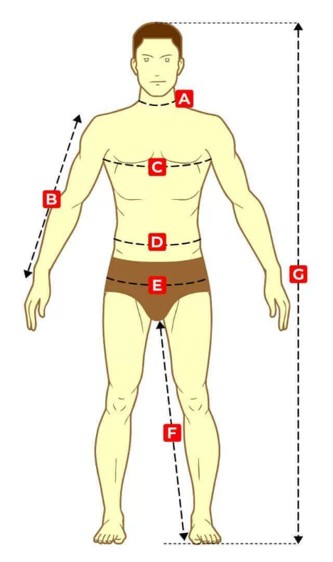Men's Suit Size Chart
| Size | A & Neck (CM) |
B & Sleeve (CM) |
C & Chest (CM) |
D & Waist (CM) |
E & Hip (CM) |
F & Inseam (CM) |
G & Height (CM) |
|---|---|---|---|---|---|---|---|
| XS | 36.0 | 55.1 | 84.0 | 72.0 | 86.0 | 74.6 | 165.0 |
| S | 37.0 | 56.2 | 88.0 | 76.0 | 90.0 | 77.8 | 168.0 |
| S | 38.0 | 57.3 | 92.0 | 80.0 | 94.0 | 79.2 | 171.0 |
| M | 39.0 | 58.4 | 96.0 | 84.0 | 98.0 | 80.6 | 174.0 |
| M | 40.0 | 59.5 | 100.0 | 88.0 | 102.0 | 82.0 | 177.0 |
| L | 41.0 | 60.4 | 104.0 | 92.0 | 106.0 | 83.4 | 180.0 |
| L | 42.0 | 61.2 | 108.0 | 96.0 | 110.0 | 84.8 | 183.0 |
| XL | 43.0 | 62.1 | 112.0 | 100.0 | 114.0 | 86.2 | 186.0 |
| XL | 44.0 | 62.3 | 116.0 | 104.0 | 118.0 | 86.2 | 187.0 |
| XXL | 45.0 | 62.6 | 120.0 | 108.0 | 122.0 | 86.2 | 188.0 |
| Men's Suit Size Guide Chart Maker : iSizeChart.com | |||||||
| Size | US | UK | EU | Russia | Japan | Korea |
|---|---|---|---|---|---|---|
| XXS | 30 | 30 | 40 | 40 | 32 | 80 |
| XS | 32 | 32 | 42 | 42 | 34 | 85 |
| S | 34 | 34 | 44 | 44 | 36 | 90 |
| S | 36 | 36 | 46 | 46 | 38 | 95 |
| M | 38 | 38 | 48 | 48 | 40 | 100 |
| M | 40 | 40 | 50 | 50 | 42 | 105 |
| L | 42 | 42 | 52 | 52 | 44 | 110 |
| L | 44 | 44 | 54 | 54 | 46 | 115 |
| XL | 46 | 46 | 56 | 56 | 48 | 120 |
| XL | 48 | 48 | 58 | 58 | 50 | 125 |
| XXL | 50 | 50 | 60 | 60 | 52 | 130 |
| XXL | 52 | 52 | 62 | 62 | 54 | 135 |
| Men's Suit Size Chart Maker : iSizeChart.com | ||||||
About Men's Suit Size Guide Chart
How to choose a suitable men's suit ?
Choosing the perfect men's suit requires attention to fit, fabric, occasion, and personal style. Here’s a comprehensive guide to help you select the ideal suit:
1. Determine the Occasion.
Weddings/Events: Consider midnight blue, black, or light gray (season-dependent).
Casual/Semi-Formal: Linen, cotton, or tweed in lighter shades (beige, light gray).
2. Focus on Fit (The Most Important Factor).
Shoulders: Seams should align with your natural shoulder line (no wrinkles or pulling).
Chest: Jacket should button comfortably with slight room (one fist of space).
Sleeves: End at the wrist bone (showing 0.5 cm of shirt cuff).
Suit Length: Covers your seat (modern fits are slightly shorter).
Pants: Sit at your waist with a slight break at the shoes.
3. Choose the Right Fabric.
Super 100s–150s: Smooth, lightweight (ideal for business).
Flannel/Tweed: Heavier, textured (winter suits).
Linen/Cotton: Lightweight, casual (wrinkles easily).
4. Select the Color & Pattern.
Charcoal Gray: Professional, formal.
Black: Strictly for funerals/black-tie events.
Patterns: Solid, Safest for business; Pinstripes, Subtle power look (finance/law); Checks/Windowpane, Creative or casual settings.
5. Pick the Style Details.
Lapels: Notch, Standard for business; Peak, Formal (tuxedos/double-breasted suits).
Vents: Single Vent, Classic (U.S. style); Double Vent: European, more mobility.
6. Tailoring Is Essential.
Avoid altering shoulders/chest—buy these right first.
7. Try Before You Buy.
Move around (sit, raise arms) to test comfort.
